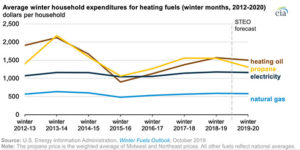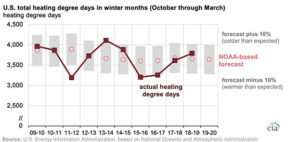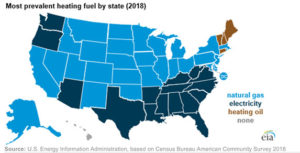EIA: Household heating expenditures to decrease this winter
Households across the United States can expect heating expenditures this winter to be lower than last year because of warmer forecast temperatures across much of the country, the U.S. Energy Information Administration (EIA) reports in its Winter Fuels Outlook.
EIA’s forecast of winter heating expenditures is based on fuel price and consumption forecasts from EIA and weather forecasts from the National Oceanic and Atmospheric Administration (NOAA).
NOAA expects the United States as a whole this winter to experience 3,635 heating degree-days, a value slightly lower – warmer – than the average of the previous 10 winters. Seven of the past 10 winters have been within 10 percent – either warmer or colder – of NOAA’s forecast.
Households using propane, EIA says, are likely to spend 15 percent less this heating season when compared to last year. Electricity and natural gas households will spend slightly less (1 percent) when compared to last year, and heating oil expenditures will decrease 4 percent from last year.
A closer look at propane
While the EIA expects propane households to spend 15 percent less on average for heating this winter compared with last winter, forecast changes in expenditures vary by region.
EIA expects that households heating with propane in the Northeast will spend an average of $228 (12 percent) less this winter than last winter, a result of prices that are 10 percent lower and average household consumption that is forecast to be 3 percent less than last winter. EIA expects households in the Midwest to spend an average of $236 (17 percent) less this winter, reflecting average prices that are about 12 percent lower than last winter and consumption that is 6 percent lower.
Lower wholesale propane prices and higher U.S. propane inventories also are worth noting with the heating expenditures forecast.
As of Sept. 30, wholesale propane spot prices at the Mont Belvieu hub were almost 60 percent lower than at the same time in 2018. EIA expects residential propane prices to be lower this winter compared with last winter because of lower crude oil and natural gas prices that feed into lower prices for retail propane and because of more abundant propane supplies nationally.
U.S. propane (including propylene) inventories were at 100.6 million barrels on Sept. 27; this was 15 percent higher than the five-year average for that time of year. The high U.S. inventories are primarily the result of inventories in the U.S. Gulf Coast that were 23 percent higher than the five-year average. Inventories were also well above average in all other regions, with the exception of the Midwest, where inventory levels were closer to the five-year average.
EIA forecasts that U.S. propane production at natural gas plants and refineries will be 12 percent higher this winter than last winter, total U.S. consumption will be 1 percent higher than last winter and net exports will be 32 percent higher than last winter.



















